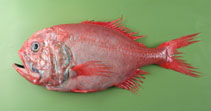| Family: |
Trachichthyidae (Slimeheads) |
| Max. size: |
75 cm TL (male/unsexed); max.weight: 7,000.0 g; max. reported age: 149 years |
| Environment: |
bathypelagic; marine; depth range 180 - 1809 m, oceanodromous |
| Distribution: |
Western Atlantic: Gulf of Maine (Ref. 4784) [in error according to Moore (Fishes of the Gulf of Maine, in press), should be off northern Nova Scotia]. Eastern Atlantic: Iceland to Morocco; Walvis Bay, Namibia to off Durban, South Africa. Indo-Pacific: south-central Indian Ocean and New Zealand. Eastern Pacific: Chile (Ref. 27363). Several stocks may exist as suggested by distinct spawning sites and seasons. |
| Diagnosis: |
Dorsal spines (total): 4-6; Dorsal soft rays (total): 15-19; Anal spines: 3-3; Anal soft rays: 10-12. Bright brick-red in color, mouth and gill cavity bluish black (Ref. 4181). Ventral scutes: 19-25. |
| Biology: |
Inhabits deep, cold waters over steep continental slopes, ocean ridges and sea-mounts. Shallow range of usual occurrence from Ref. 27121. Appears to be dispersed over both rough bottoms and steep, rough grounds where it feeds on crustaceans and fish. In New Zealand, the main prey include mesopelagic and benthopelagic prawns, fish, and squid, with other organisms such as mysids, amphipods and euphausiids occasionally being important (Ref. 9072). Juveniles feed mainly on crustaceans (Ref. 27075, 27076). Grows very slowly and is one of the longest lived fish species known. Based on parasite and trace-element analyses, orange roughy is a sedentary species with little movement between fish-management zones (Ref. 27089). Little is known of the larvae and juveniles which are probably confined to deep water (Ref. 27088). The fishery targets sporadically formed dense spawning and non-spawning aggregations. Marketed fresh and frozen; eaten steamed, fried, microwaved and baked (Ref. 9988). Because of severe overfishing the species has been listed as threatened by the Australian Government in 2006. |
| IUCN Red List Status: |
Not Evaluated (N.E.) Ref. (130435)
|
| Threat to humans: |
harmless |
Source and more info: www.fishbase.org. For personal, classroom, and other internal use only. Not for publication.

